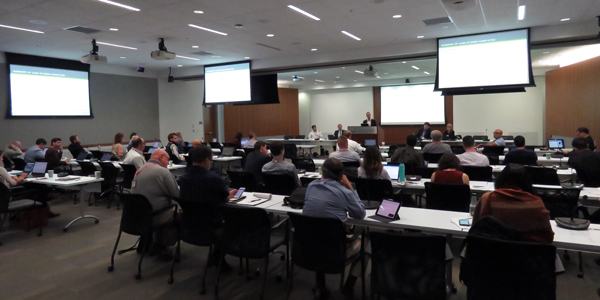By Jason Fordney
FOLSOM, Calif. — California agencies are finalizing a roadmap for commercializing microgrids in the state, aligning with a $45 million grant funding opportunity for the technology.
“We had a huge amount of questions and answers — in fact, the largest we have had for any solicitation,” Mike Gravely of the California Energy Commission said at an Oct. 2 workshop to discuss the funding initiative. He cautioned that the roadmap is still preliminary and that his agency is “very much interested in the consensus of the industry.”
Microgrids — independent, controllable energy systems with a single point of interconnection to the grid — are increasingly being studied as an option to help integrate renewables, not just in the U.S., but also in Europe and Asia, where solar development is on the rise.
The commission is taking comments through Oct. 28 on its draft roadmap for commercializing microgrids, issued late last month. The agency is offering grants for microgrid development in the state on military bases, ports and tribal lands; in low-income and rural areas; and at industrial complexes and local schools. (See California Awarding $45 Million for Microgrids.)
The funding opportunity is the second to be issued by the commission, and a third one is under review and due to be released by the end of the year. Earlier solicitations provided more than $70 million for 18 to 20 microgrids.
“We will be a big player in this market,” Gravely said, adding that a lot of the activities in the roadmap will be implemented through a CEC research process before going to the California Public Utilities Commission and CAISO, and some will be implemented through existing proceedings.
Some questions around microgrid implementation remain unanswered, including who carries the costs, who pays for interconnection and what fees will apply to microgrids. While there are no particular legislative or regulatory directives to develop microgrids, the issues around their implementation cross over other state proceedings on interconnection, energy storage and distributed energy. The PUC’s “Distributed Resources Plans” proceeding has authorized development of two microgrids: one in Borrego Springs, in San Diego Gas & Electric territory, and another in Mono County, in Southern California Edison’s area.
The services model for microgrids is still evolving, Adam Forni of Navigant Consulting said in a presentation on a recent global survey of the technology. Almost every microgrid in California uses solar in conjunction with energy storage, while overseas applications often utilize back-up diesel generation.
The projects examined in the Navigant study, which is meant to help the CEC shape the roadmap, had to be at least 50% privately funded and be already online or commencing operation within the next year. Navigant studied nine projects in California, 10 others on the North American continent and seven additional projects in China, Singapore, Hawaii, India, Japan and Mozambique. International and North American projects were built more for reliability, while California projects were designed mainly to meet environmental goals.
Facilities included commercial hosts, government entities, landfills, affordable housing, agriculture and food production, with most rated at 1 MW or above and three larger than 10 MW. Navigant recommended that the state focus research and development on technologies that enhance integration to reduce reliance on diesel generators, not to limit funding to just solar plus energy storage and to incorporate more diverse renewable sources. The consulting group also recommended considering the other benefits that microgrids can provide outside of electricity, including thermal energy, water and waste management solutions.





